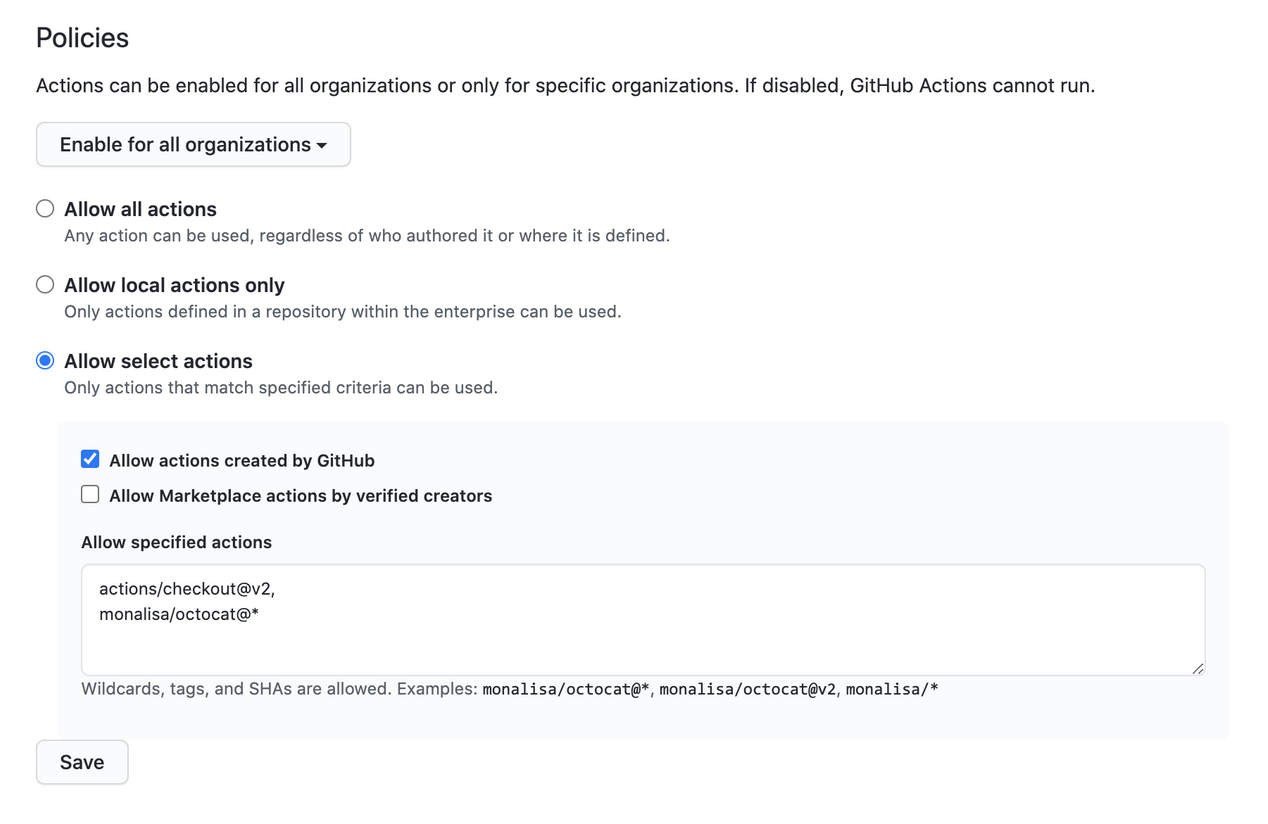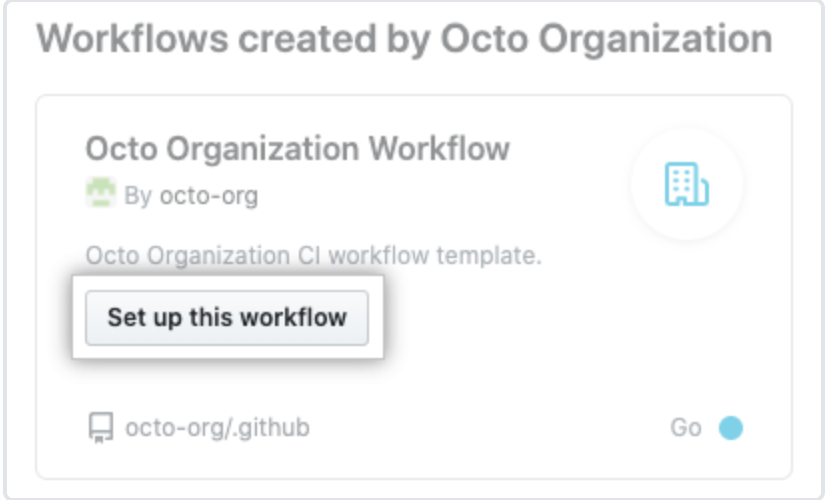Manage actions and workflows
Here, you'll explore the different tools and strategies available to you in GitHub Enterprise Cloud and GitHub Enterprise Server in order to share GitHub actions and workflows and manage their use within your enterprise.
The content is structured around the level at which the tools presented are available: enterprise level or organizational level.
At enterprise level
Configure a GitHub Actions use policy
GitHub Actions workflows often contain actions, which are sets of standalone commands to be executed within the workflow. When creating a workflow, you can create your own actions to use, or reference public community actions available from GitHub Marketplace. For this reason, configuring a use policy for workflows and actions in your enterprise is essential to prevent users from using malicious third-party actions.
You have several options in Enterprise Cloud to configure a policy, as well as in Enterprise Server if GitHub Connect is enabled in your enterprise settings.
To configure a GitHub Actions use policy for your enterprise, navigate to your enterprise account and then to Policies > Actions in the sidebar. The following options should appear.

The dropdown at the top labeled Enable for all organizations enables you to decide which organizations in your enterprise can use GitHub Actions (all of them, some of them or none of them), while the three options underneath enable you to define the restriction level of GitHub Actions within these organizations.
If you want to enable only specific actions to be used within your enterprise, select Allow enterprise, and select non-enterprise, actions and reusable workflows, and choose the option corresponding to your use case.

Manually sync public actions for Enterprise Server
Most official GitHub-authored actions come automatically bundled with Enterprise Server, and they're captured at a point in time from the GitHub Marketplace. They include actions/checkout, actions/upload-artifact, actions/download-artifact, actions/labeler, and various actions/setup- actions, among others. To get all the official actions included on your enterprise instance, browse to the actions organization on your instance: https://HOSTNAME/actions.
As mentioned in the Configure a GitHub Actions use policy section, it's possible to configure Enterprise Server to automatically access the public actions available in the GitHub Marketplace and to configure a use policy for them. However, if you want stricter control over the public actions that should be made available in your enterprise, you can manually download and sync actions into your enterprise instance using the actions-sync tool.
At organization level
Document corporate standards
Creating a GitHub Actions workflow often involves writing multiple files and creating several repositories to specify the workflow in itself. Creating also includes the actions, containers, and/or runners to use in the workflow. Depending on the number of users in your Enterprise Cloud or Enterprise Server instance, things can get messy pretty quickly if you don't have corporate standards in place for creating GitHub Actions workflows.
As a best practice, we recommend you document the following in a GitHub wiki or as a markdown file in a repository accessible to all within an organization:
- Repositories for storage
- Files/folders naming conventions
- Location of shared components
- Plans for ongoing maintenance
- Contribution guidelines
Create workflow templates
Workflow templates are a great way to ensure automation is reused and maintained in your enterprise. Both in Enterprise Cloud and Enterprise Server, users with write access to an organization's .github repository can create workflow templates that will be available for use to the other organization's members with the same write access. Workflow templates can then be used to create new workflows in the public and private repositories of the organization.
Creating a workflow template is done in two steps:
Create a yml workflow file.
Create a json metadata file that describes how the template should be presented to users when they're creating a workflow.
Note
The metadata file must have the same name as the workflow file. Instead of the .yml extension, it must be appended with .properties.json. For example, a file named octo-organization-ci.properties.json contains the metadata for the workflow file named octo-organization-ci.yml.
Both files must be placed in a public .github repository and in a directory named workflow-templates. You might have to create these if they don't already exist in your organization.
The following is an example of a basic workflow file:
name: Octo Organization CI
on:
push:
branches: [ $default-branch ]
pull_request:
branches: [ $default-branch ]
jobs:
build:
runs-on: ubuntu-latest
steps:
- uses: actions/checkout@v2
- name: Run a one-line script
run: echo Hello from Octo Organization
Note that the preceding file uses a $default-branch placeholder. When a workflow is created using your template, this placeholder is automatically replaced with the name of the repository's default branch.
Following is the metadata file you would create for the workflow file:
{
"name": "Octo Organization Workflow",
"description": "Octo Organization CI workflow template.",
"iconName": "example-icon",
"categories": [
"Go"
],
"filePatterns": [
"package.json$",
"^Dockerfile",
".*\\.md$"
]
}
Metadata files use the following parameters:
| Parameter | Description | Required |
|---|---|---|
| name | Name of the workflow template displayed in the list of available templates. | Yes |
| description | Description of the workflow template displayed in the list of available templates. | Yes |
| iconName | Defines an icon for the workflow's entry in the template list. Must be an SVG icon of the same name, and must be stored in the workflow-templates directory. For example, an SVG file named example-icon.svg is referenced as example-icon. | No |
| categories | Defines the language category of the workflow. When a user views the available templates, the templates that match the same language will feature more prominently. | No |
| filePatterns | Enables the template to be used if the user's repository has a file in its root directory that matches a defined regular expression. | No |
Once a workflow template is created, users in your organization can find it under Actions > New workflow > Workflows created by _your_organization_name.

Reusable Templates for Actions and Workflows
GitHub Actions allows for workflow automation, and a key part of managing workflows efficiently is using reusable templates. Reusable templates help standardize and streamline development across multiple repositories, reducing redundancy and improving maintainability.
Reusable templates in GitHub Actions refer to predefined actions and workflows that can be referenced and used across multiple projects. They ensure consistency and compliance with enterprise-wide standards.
Types of reusable templates
| Template Type | Purpose | Example |
|---|---|---|
| Reusable Workflows | Standardize CI/CD pipelines across repositories. | ci-pipeline.yml, deploy-app.yml |
| Reusable Actions | Encapsulate common automation logic. | setup-env-action, security-scan-action |
| Workflow Templates | Define reusable job structures. | test-job.yml, build-job.yml |
Reusable workflows
A reusable workflow is a workflow defined in a separate repository that can be referenced in multiple projects. This allows organizations to centralize their CI/CD logic.
Structure of a reusable workflow
A reusable workflow is stored in .github/workflows/ and uses the workflow_call trigger.
Example: Standardized CI workflow (ci-pipeline.yml)
name: CI Pipeline
on:
workflow_call:
inputs:
node-version:
required: true
type: string
secrets:
npm-token:
required: true
jobs:
build:
runs-on: ubuntu-latest
steps:
- uses: actions/checkout@v3
- name: Set up Node.js
uses: actions/setup-node@v3
with:
node-version: ${{ inputs.node-version }}
registry-url: 'https://npm.pkg.github.com/'
- name: Install Dependencies
run: npm install
- name: Run Tests
run: npm test
Using a reusable workflow in another repository
Once defined, the reusable workflow can be used in any repository via the uses: keyword.
Example: Calling the reusable workflow
name: Reusable CI Pipeline
on: push
jobs:
test:
uses: org/reusable-workflows/.github/workflows/ci-pipeline.yml@v1
with:
node-version: '16'
secrets:
npm-token: ${{ secrets.NPM_TOKEN }}
Benefits of using a reusable workflow
- Ensures all repositories follow the same CI/CD structure.
- Reduces redundancy and maintenance overhead.
- Allows for centralized updates without modifying each repository.
Reusable actions
A GitHub Action is a modular, reusable unit that executes specific automation tasks. Organizations often create custom actions to encapsulate frequently used logic.
Structure of a reusable action
A reusable action is defined in an action repository with an action.yml file.
Example: Custom Setup Environment Action
name: "Setup Environment"
description: "Sets up Node.js and installs dependencies"
inputs:
node-version:
description: "Node.js version"
required: true
registry-url:
description: "NPM Registry URL"
required: false
default: "https://registry.npmjs.org/"
runs:
using: "node16"
main: "index.js"
Using a reusable action in a workflow
Instead of repeating setup steps in every workflow, we use our custom action:
name: Build & Test
on: push
jobs:
build:
runs-on: ubuntu-latest
steps:
- uses: actions/checkout@v3
- name: Setup Environment
uses: org/actions/setup-env@v1
with:
node-version: '16'
Benefits:
- Reduces duplication of setup logic across repositories.
- Simplifies workflow files, making them more readable.
- Centralizes updates—fixes or improvements in one place reflect across all workflows.
Workflow templates
As discussed earlier, workflow templates help standardize automation across your organization by providing predefined structures for common tasks. These templates are a key part of the broader category of reusable workflows.
In the earlier section "Create workflow templates," we outlined how to build these templates from a yml file and a corresponding .properties.json metadata file.
To further connect the concept: workflow templates are a form of reusable workflow. When you create and store them in a public .github repository under the workflow-templates/ directory, they allow other organization members to create consistent workflows for their repositories without having to define them from scratch.
By leveraging workflow templates, enterprises can:
- Enforce best practices across repositories.
- Accelerate onboarding and setup for new projects.
- Maintain consistency in CI/CD processes.